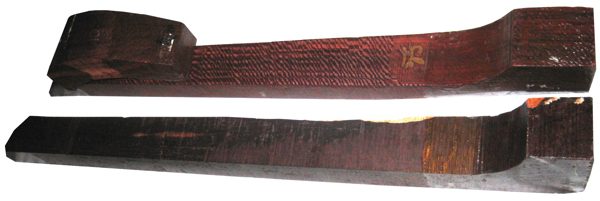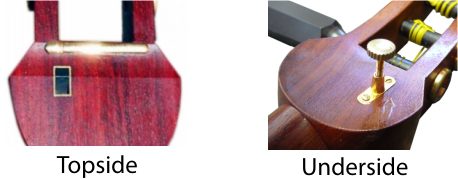Like buying any instrument, there are a few important factors to know in making an informed purchase. If this is your first time buying a shamisen, the information below will help you decide what shamisen materials are right for you.

The quality of wood for the sao (neck) is the main way shamisen are priced. It is generally considered that harder woods make better shamisen sao. It’s also claimed that the hardness of the neck affects the sound quality, but considerably? I doubt it. These are the three main kinds of traditional wood used for tsugaru shamisen.

Karin wood is used to for low-end shamisen. It is softer and more widely available than the following woods, so shamisen makers use this to build affordable models. The downside of a Karin sao is it may warp and wear more than heavier woods below.
Note All dou are made from Karin wood of varying grades, depending on the quality of shamisen. E.g, cheaper shamisen uses low-grade Karin. Good wood, but without fancy grain patterns. Expensive shamisen uses very high grade Karin which is harder and has luscious grain patterns.

This is the next level in quality. Shitan wood is harder than Karin, which makes a better neck. However, it is also more endangered which means it’s more expensive.

This is the highest quality wood for shamisen. Kouki makes the best neck and also looks exquisite. Unfortunately, it is the most expensive wood, as it’s even more endangered than Shitan.
Note Though a shamisen with kouki wood is referred to as a “kouki shamisen”, the dou is made from high-grade Karin.
The above-mentioned materials are considered “standard” woods within the shamisen paradigm. However, amazing shamisen can be made with materials such as Maple, Purpleheart, Oak and more. For example, I have played a Maple shamisen built by a master craftsman and it sounded just as good as any shamisen made with “standard” woods. As long as the shamisen is skillfully crafted, it can be built from a wide variety of woods.
The skin is the most important part as it influences about 80% of the sound quality. There are two kinds of skin used on tsugaru shamisen.
Natural skin

Natural skin for tsugaru shamisen used to be thick dog skin, but nowadays, it is being replaced with goat skin. Natural skin produces a very warm and responsive sound. It’s also fun to talk about on a first date! Anywho, a professionally stretched skin really makes the shamisen sound alive and is well worth the cost if you can afford it.
The downside? Being a natural material, it affected by climate, moisture and stress. If you live in a climate that changes considerably, the skin may only last a year or two. If your climate is consistent (like it is in California) or you keep your shamisen indoors, the skin may last more than seven years. To get the best sound quality, watch how to properly care for the skin.
FiberSen: Advanced Synthetic Skin
FiberSen is an advanced synthetic material different from older versions of plastic skin used for shamisen (which was created by layers of film). FiberSen can be stretched much farther and so produces a much sharper and brighter sound that lasts for years. Unlike plastic skin (which sounds like plastic), FiberSen skin sounds very similar to natural skin. Jamming in the park and it starts to rain? No worries! Fibersen is waterproof! Watch the official video!.
There are two kinds of sao used on a shamisen.
Mitsuori
Mitsuori sao can be dismantled into three pieces. This makes the shamisen easier to transport and reduces risk of warping. It should also be mentioned that the pieces connect perfectly on specific position marks. This is useful for a fretless instrument. The hairline formed by the joint is almost like a fret, as it highlights certain positions to press the string.

Disassembling a mitsuori sao isn’t difficult, but it is crucial to know exactly what to do. For your understanding and enjoyment, watch Masahiro Nitta explain how to separate and assemble a mitsuori sao.
Nobezao
Nobezao is a single piece sao. It has no real disadvantages, other than it can’t be disassembled for easier transport. Because making a nobezao is easier than making a mitsuori sao, it is cheaper.

Sawari
All shamisen are made so the first string emits a buzzing sound, almost like a sitar. For nagauta shamisen, cheaper jiuta and tsugaru shamisen, this is how the tenjin (headpiece) will look in the picture below. As you can see, the kamigoma (metal strip) is under the two thinner strings while the ichi no ito (thick string) rests on bare wood. When struck, the thick string vibrates against the little ridge (sawari yama), making the buzzing sound.

In the 1890s, a mechanical device was made to adjust the amount of buzzing on high quality jiuta and tsugaru shamisen. As you can see in the picture below, the kamigoma is under all the strings and the device is installed under the ichi no ito. Watch how to use the azuma sawari.

Though low-end shamisen don’t include the azuma sawari device, it still has the sawari buzzing effect. Why spend more on an azuma sawari? Well, the advantage is that you can adjust the amount of buzz created. Switching string gauges or tunings require adjustment to the azuma sawari for maintaining the cleanest buzz, which can’t be done on a low-end shamisen.
